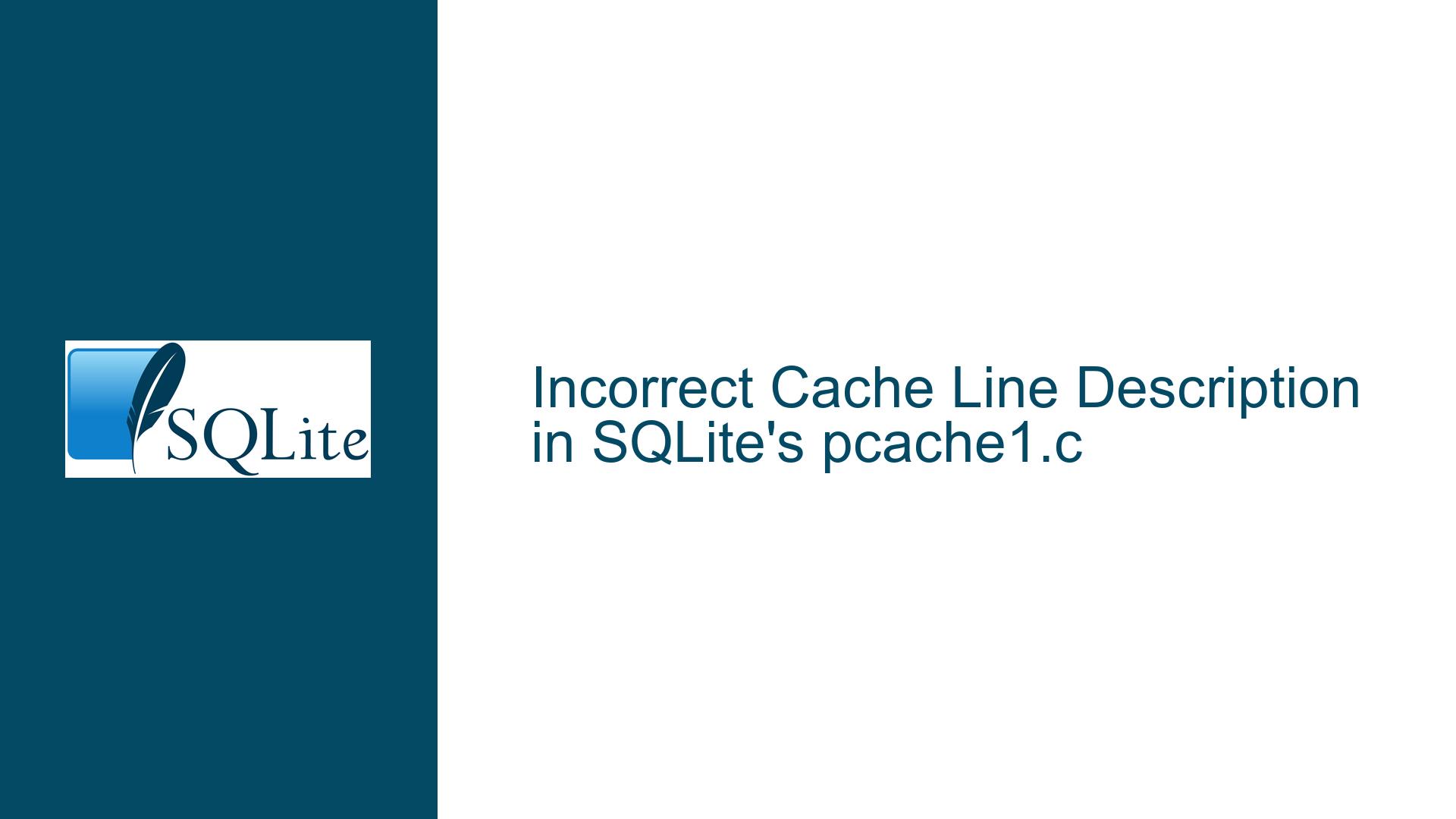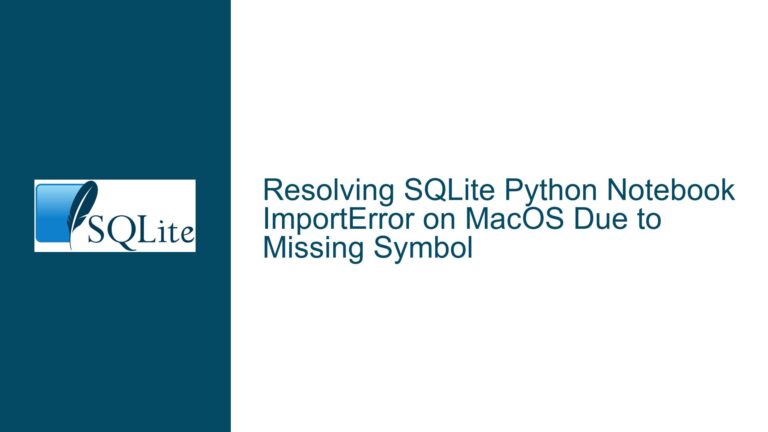Incorrect Cache Line Description in SQLite’s pcache1.c
Issue Overview: Misalignment Between Cache Line Description and Implementation
The core issue revolves around a discrepancy between the documented cache line structure in SQLite’s pcache1.c file and the actual implementation in the code. The cache line description in the source code comments suggests a specific memory layout for the components involved in page caching: database page content, PgHdr1, MemPage, and PgHdr. However, a closer examination of the code reveals that the actual memory layout does not match the documented description. Specifically, the positions of PgHdr and MemPage appear to be swapped in practice.
This misalignment is significant because the cache line structure is critical to SQLite’s page cache mechanism, which is responsible for managing database pages in memory. The page cache is a performance-sensitive component, and any inconsistency between the documented structure and the actual implementation could lead to subtle bugs, memory corruption, or performance degradation. The issue is particularly concerning because it involves low-level memory manipulation, where even small errors can have far-reaching consequences.
The cache line structure is used to store metadata about database pages, including pointers to the page content, additional page-related data, and linked list pointers for cache management. The PgHdr1 structure is a key component, as it contains metadata about the page, such as whether it is part of a bulk operation or an anchor page. The PgHdr structure, on the other hand, is used to manage the page within the cache, including pointers to the next and previous pages in the cache’s LRU (Least Recently Used) list. The MemPage structure represents the actual database page content.
The discrepancy arises in the way the code allocates and initializes these structures. In the implementation, the PgHdr structure is placed immediately after the PgHdr1 structure, followed by the MemPage structure. However, the comment suggests that the MemPage structure should come before the PgHdr structure. This inconsistency could lead to incorrect memory access patterns, especially if other parts of the code rely on the documented structure.
Possible Causes: Miscommunication or Outdated Documentation
The root cause of this issue likely stems from one of two scenarios: either the documentation in the source code comments is outdated and no longer reflects the current implementation, or there was a miscommunication during the development process that led to the discrepancy. Both scenarios are common in large codebases, especially those with a long history like SQLite.
In the first scenario, the cache line structure might have been modified at some point during the development of SQLite, but the corresponding documentation was not updated to reflect these changes. This could happen if the changes were made in a hurry or if the developers assumed that the code itself would serve as sufficient documentation. Over time, the outdated comment could have been overlooked, leading to the current inconsistency.
In the second scenario, the discrepancy could be the result of a miscommunication between the developers responsible for implementing the cache line structure and those responsible for documenting it. For example, the developers might have agreed on a specific memory layout during a design meeting, but the implementation deviated from this agreement without the documentation being updated. This could happen if the implementation was done by a different developer or if the changes were made in a separate branch and later merged without proper review.
Another possible cause is that the comment was written based on an earlier version of the code, and the implementation was later optimized or refactored without updating the comment. This is particularly plausible in performance-critical components like the page cache, where even small optimizations can have a significant impact. For example, the developers might have decided to reorder the structures to improve memory alignment or reduce cache misses, but forgot to update the comment to reflect this change.
Regardless of the specific cause, the discrepancy between the documented cache line structure and the actual implementation is a potential source of confusion for developers working on the code. It could also lead to bugs if other parts of the codebase rely on the documented structure for memory calculations or pointer arithmetic.
Troubleshooting Steps, Solutions & Fixes: Aligning Documentation with Implementation
To resolve this issue, the first step is to verify the actual memory layout used by the code. This can be done by carefully analyzing the relevant sections of the pcache1.c file, particularly the code that allocates and initializes the cache line structures. The key sections to examine are the lines where the PgHdr1, PgHdr, and MemPage structures are allocated and initialized.
In the first code snippet, the PgHdr1 structure is allocated immediately after the database page content, and the PgHdr structure is initialized using pointer arithmetic. The pCache->szPage variable represents the size of the database page content, and the ROUND8 macro is used to ensure proper alignment. The p->page.pExtra pointer is set to point to the memory immediately after the PgHdr1 structure, which is where the PgHdr structure is located. This suggests that the PgHdr structure comes after the PgHdr1 structure in memory.
In the second code snippet, the PgHdr structure is initialized with pointers to the page content and additional data. The pPgHdr->pExtra pointer is set to point to the memory immediately after the PgHdr structure, which is where the MemPage structure is located. This confirms that the MemPage structure comes after the PgHdr structure in memory.
Based on this analysis, it is clear that the actual memory layout is database page content | PgHdr1 | PgHdr | MemPage, which contradicts the documented layout of database page content | PgHdr1 | MemPage | PgHdr. To fix this issue, the documentation in the source code comments should be updated to reflect the actual memory layout used by the code.
The updated cache line description should be as follows:
** ------------------------------------------------------------- **
| database page content | PgHdr1 | PgHdr | MemPage |
** ------------------------------------------------------------- **
This change ensures that the documentation accurately reflects the implementation, reducing the risk of confusion or bugs in the future. It is also important to review other parts of the codebase that might rely on the documented cache line structure to ensure that they are compatible with the actual layout. For example, any code that performs pointer arithmetic or memory calculations based on the documented structure should be updated to match the actual layout.
In addition to updating the documentation, it is a good practice to add assertions or runtime checks to verify that the cache line structure is correctly aligned in memory. This can help catch any potential issues early and ensure that the code behaves as expected. For example, the assert( EIGHT_BYTE_ALIGNMENT( p->page.pExtra ) ); statement in the first code snippet already checks that the pExtra pointer is properly aligned, but additional checks could be added to verify the positions of the PgHdr and MemPage structures.
Finally, it is worth considering whether the current memory layout is optimal or if it could be further improved. For example, reordering the structures to improve memory alignment or reduce cache misses could lead to performance improvements. However, any changes to the memory layout should be carefully tested to ensure that they do not introduce new bugs or regressions.
In conclusion, the discrepancy between the documented cache line structure and the actual implementation in SQLite’s pcache1.c file is a potential source of confusion and bugs. By carefully analyzing the code, updating the documentation, and adding runtime checks, this issue can be resolved, ensuring that the page cache mechanism operates correctly and efficiently.






